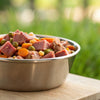How Much Pumpkin to Feed Your Dog: A Comprehensive Guide to Pumpkin Benefits and Safe Feeding Practices
- Houndsy
Table of Contents
- Introduction
- The Nutritional Benefits of Pumpkin
- How Much Pumpkin to Feed Your Dog
- Types of Pumpkin Safe for Dogs
- Preparing Pumpkin for Your Dog
- Safety Considerations
- Conclusion
- FAQs
Introduction
Did you know that nearly 20% of dogs experience digestive issues at some point in their lives? Whether it's constipation, diarrhea, or simply the need for a fiber boost, many dog owners find themselves searching for natural remedies. One popular option that veterinarians often recommend is pumpkin. This nutrient-rich fruit not only assists with digestion but also offers a host of other health benefits for our canine companions.
In this blog post, we will dive deep into the world of pumpkin and its suitability for dogs. We’ll explore how much pumpkin to feed your dog, the different types of pumpkin, preparation methods, and the health benefits that come with this delicious treat. By the end of this guide, you'll have a comprehensive understanding of how to incorporate pumpkin into your dog's diet safely and effectively.
So, let's take a moment to reflect on our own feeding routines: Do we know exactly what our dogs are consuming? Are we leveraging natural foods like pumpkin to enhance their health? Join us on this journey to discover the wonderful world of pumpkin for dogs.
The Nutritional Benefits of Pumpkin
Pumpkin is more than just a seasonal decoration; it's a powerhouse of nutrition for dogs. Here are some key benefits:
1. High in Fiber
Pumpkin is rich in soluble fiber, which can help regulate your dog’s digestive system. Fiber absorbs water, adds bulk to stools, and helps them pass more easily, making it beneficial for both constipation and diarrhea.
2. Packed with Vitamins and Minerals
Pumpkin contains several essential vitamins and minerals, including:
- Vitamin A: Supports vision and immune function.
- Vitamin C: Boosts immunity and aids in collagen production.
- Vitamin E: Acts as an antioxidant, protecting cells from damage.
- Potassium: Supports muscle function and heart health.
- Iron: Essential for oxygen transport in the blood.
3. Low in Calories
For pet owners concerned about their dog's weight, pumpkin offers a low-calorie option to help bulk up meals without adding excessive calories. With approximately 5 calories per tablespoon, it's an excellent choice for dogs on a diet.
4. Supports Digestive Health
The fiber in pumpkin acts as a prebiotic, feeding the beneficial bacteria in your dog's gut. This can help maintain a healthy digestive system and promote overall health.
How Much Pumpkin to Feed Your Dog
While pumpkin can be a beneficial addition to your dog's diet, it's crucial to feed it in moderation. The right amount can vary based on your dog's size and health needs. Here’s a general guideline:
- Small dogs (under 20 lbs): Start with 1-2 teaspoons of pumpkin per meal.
- Medium dogs (21-50 lbs): 1-2 tablespoons of pumpkin per meal.
- Large dogs (51 lbs and up): 2-4 tablespoons of pumpkin per meal.
It’s important to monitor your dog’s reaction when introducing pumpkin to their diet. If you notice any signs of digestive upset, reduce the amount or consult your veterinarian.
Types of Pumpkin Safe for Dogs
When it comes to feeding pumpkin to your dog, not all types are created equal. Here’s what you need to know:
1. Canned Pumpkin
Plain canned pumpkin is one of the most convenient options. Make sure it’s 100% pumpkin with no added sugars or spices. Avoid pumpkin pie filling, which can contain harmful ingredients like sugar and xylitol.
2. Fresh Pumpkin
You can also use fresh pumpkin. Simply remove the seeds and pulp, then cook it by baking, boiling, or steaming until soft. Mash or puree it before serving.
3. Pumpkin Seeds
Pumpkin seeds are safe for dogs and can be a nutritious snack. They contain healthy fats and minerals. However, they should be roasted and ground to reduce the risk of choking, especially for small dogs.
Preparing Pumpkin for Your Dog
1. Canned Pumpkin
The easiest way to serve pumpkin is straight from the can. Just be sure to select a brand that contains no additives.
2. Fresh Pumpkin
If you're using fresh pumpkin, follow these steps:
- Cut the pumpkin in half and scoop out the seeds and stringy pulp.
- Roast or boil the pumpkin until it’s soft.
- Allow it to cool, then mash or puree it before serving.
3. Pumpkin Treats
You can also incorporate pumpkin into homemade dog treats. Here’s a simple recipe to try:
Pumpkin Dog Treats Recipe
- 1 cup of plain canned pumpkin
- 2 ½ cups of whole wheat flour
- 1 egg
- ½ cup of peanut butter (ensure it’s xylitol-free)
- Mix all ingredients to form a dough, roll out, and cut into shapes.
- Bake at 350°F for 20-25 minutes or until firm.
Safety Considerations
1. Introduce Slowly
Always introduce any new food gradually to your dog’s diet to avoid upset stomachs. Start with a small quantity and observe how your dog reacts.
2. Avoid Overfeeding
While pumpkin is healthy, too much can lead to digestive issues, including diarrhea. Stick to the recommended amounts based on your dog’s size.
3. Consult Your Veterinarian
If your dog has underlying health issues, especially digestive problems, it's best to consult your veterinarian before adding pumpkin to their diet.
Conclusion
Pumpkin is a versatile and nutritious food that can provide numerous benefits for your dog's digestive health. By understanding how much pumpkin to feed your dog and how to prepare it safely, you can enhance their diet with this delicious treat. Whether you’re dealing with digestive issues or simply want to provide a healthy snack, pumpkin can be an excellent choice.
As responsible pet owners, it's essential to continuously reflect on our pets' diets and ensure they receive the best nutrition. Have you tried incorporating pumpkin into your dog's meals? If you’re looking for a convenient way to elevate your dog’s feeding experience, consider the Houndsy Kibble Dispenser. Not only does it provide perfect portion control, but it also complements your modern home decor.
FAQs
Can dogs eat raw pumpkin?
While dogs can technically eat raw pumpkin, it may be harder for them to digest. Cooked pumpkin is easier on their stomachs.
How often can I give my dog pumpkin?
You can add pumpkin to your dog’s meals a few times a week, or daily if addressing specific health issues.
Can pumpkin help with dog diarrhea?
Yes, the soluble fiber in pumpkin can help firm up loose stools and regulate your dog's digestive system.
Is pumpkin safe for puppies?
Yes, puppies can eat pumpkin, but start with smaller amounts and ensure it’s well-cooked and pureed.
What should I avoid when feeding pumpkin to my dog?
Avoid pumpkin pie filling and any canned pumpkin products that contain added sugars or spices. Always choose plain, pure pumpkin.
By understanding the benefits and safe practices surrounding pumpkin for dogs, we can enhance our furry friends' diets and promote a healthier lifestyle. Happy feeding!













